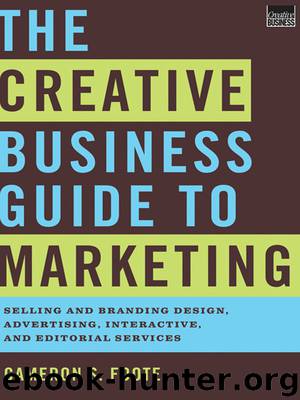The Creative Business Guide to Marketing: Selling and Branding Design, Advertising, Interactive, and Editorial Services by Cameron S. Foote

Author:Cameron S. Foote
Language: eng
Format: epub
Publisher: W. W. Norton
MAKING A GREAT PROCESS PRESENTATION
A process presentation is oriented around the way a firm thinks and works. As would be expected, it is the type of new business presentation best suited to process-based firms involved with ongoing account work, such as agencies. But it is also the right approach for project-based organizations, such as design firms, when prospects’ needs are strategy-heavy, multi-faceted, and long-term. Generally, in such situations a prospect will be most interested in a firm’s investigational, creative, and implementation processes, and less interested in examples of its previous work. In other words, the higher the level and more unusual the challenge, the more important a firm’s problemsolving and challenge-addressing processes become.
Aside from agency account pitches, projects for which an emphasis on process is usually more effective include branding and identity, packaging, new product introductions, industrial design, interactive site development, public relations representation, and communications consulting. Assignments in these areas are often unusual enough that samples of previous work are not nearly as relevant as how a firm goes about addressing the challenges it’s been given. Showing samples can also be somewhat irrelevant where high-level work is involved because the reputations of those invited to compete are often well known and respected. The firms’ competence, their ability to produce an outstanding creative product, is a given. What’s not known—the purpose of the presentation—is how they will rise to a challenge, the depth of their strategic thinking, the resources they can marshal, their relevant experiences, and how well their personnel will team with a prospect's.
All this makes a process presentation more demanding. Whereas presenting a portfolio is routine “show and tell,” describing processes requires specific “explain and persuade.” With less to show, a presenter has fewer crutches. The need to describe intangibles puts greater emphasis on verbal skills. And each pitch has to be highly customized. Nonetheless, a good process presentation is well within the capability of any reasonably articulate individual.
HOW MUCH TIME? The length of a process presentation meeting should, of course, depend on the prospective client and the opportunity. This said, one hour is usually sufficient for all but the most involved projects. It provides time enough to get to know the prospect and to introduce your firm’s experience, processes, and capabilities. Short meetings are respectful of the prospect’s time, an important consideration when several individuals are involved. They are also easier to schedule, which can otherwise be a problem. And they force presenters to be organized.
THE TEAM. Although not an option for single-person firms or firms without appropriate personnel, the best process presentations are team efforts. The norm is a team of three: a principal, whoever will be responsible for the business (sales person or account executive), and the person responsible for the product (creative director).
When large organizations are pitching small clients and opportunities, principals need not be involved. At least a senior officer should be, though. Presentation psychology dictates that every prospective client feel important enough to warrant the attention of senior management. On the other
Download
This site does not store any files on its server. We only index and link to content provided by other sites. Please contact the content providers to delete copyright contents if any and email us, we'll remove relevant links or contents immediately.
| Advertising | Annuals |
| Book Design | Branding & Logo Design |
| Fashion Design | Illustration |
| Science Illustration |
Wonder by R.J. Palacio(8470)
Mastering Adobe Animate 2023 - Third Edition by Joseph Labrecque(3790)
Unlabel: Selling You Without Selling Out by Marc Ecko(3593)
Ogilvy on Advertising by David Ogilvy(3520)
Hidden Persuasion: 33 psychological influence techniques in advertising by Marc Andrews & Matthijs van Leeuwen & Rick van Baaren(3476)
Drawing Cutting Edge Anatomy by Christopher Hart(3454)
The Pixar Touch by David A. Price(3369)
POP by Steven Heller(3309)
The Code Book by Simon Singh(3078)
Slugfest by Reed Tucker(2946)
The Art of War Visualized by Jessica Hagy(2945)
The Curated Closet by Anuschka Rees(2917)
Rapid Viz: A New Method for the Rapid Visualization of Ideas by Kurt Hanks & Larry Belliston(2836)
Stacked Decks by The Rotenberg Collection(2812)
365 Days of Wonder by R.J. Palacio(2757)
The Wardrobe Wakeup by Lois Joy Johnson(2734)
Keep Going by Austin Kleon(2701)
Tattoo Art by Doralba Picerno(2601)
Tell Me More by Kelly Corrigan(2592)
